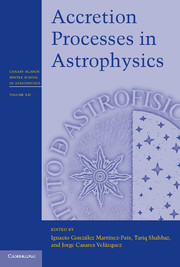Book contents
- Frontmatter
- Contents
- List of contributors
- List of participants
- Preface
- Acknowledgments
- Abbreviaions
- 1 Accretion disks
- 2 The evolution of binary systems
- 3 Accretion onto white dwarfs
- 4 Multiwavelength observations of accretion in low-mass X-ray binary systems
- 5 X-ray binary populations in galaxies
- 6 Observational characteristics of accretion onto black holes I
- 7 Observational characteristics of accretion onto black holes II: environment and feedback
- 8 Computing black-hole accretion
- A Piazzi Smyth, the Cape of Good Hope, Tenerife, and the siting of large telescopes
- References
8 - Computing black-hole accretion
Published online by Cambridge University Press: 05 January 2014
- Frontmatter
- Contents
- List of contributors
- List of participants
- Preface
- Acknowledgments
- Abbreviaions
- 1 Accretion disks
- 2 The evolution of binary systems
- 3 Accretion onto white dwarfs
- 4 Multiwavelength observations of accretion in low-mass X-ray binary systems
- 5 X-ray binary populations in galaxies
- 6 Observational characteristics of accretion onto black holes I
- 7 Observational characteristics of accretion onto black holes II: environment and feedback
- 8 Computing black-hole accretion
- A Piazzi Smyth, the Cape of Good Hope, Tenerife, and the siting of large telescopes
- References
Summary
8.1 Introduction
Astronomers have a remarkably successful theory for stars and stellar evolution. This success is due in part to the simplicity of spherical symmetry and steady-state equilibrium. Stars can be modeled using a series of time-independent equations that depend on only one spatial coordinate, namely the radius of the star. But the universe is a much more dynamic and active place than is implied by the stars alone. Some of the most energetic photons that astronomers observe originate not within stars but in orbiting disks of gas. This realization has brought the study of accretion disks to the forefront of high-energy astrophysics.
The idea of an orbiting disk of gas in a context other than that of a nascent solar system or spiral galaxy can be traced at least as far back as the work of astronomer Gerard Kuiper on mass transfer in close binary stellar systems. He noted that in such systems, gas can flow through a stream from one star to the other. Kuiper realized that the gas would possess sufficient angular momentum that it must go into orbit around the attracting star, forming a ring.
In 1955, John Crawford and Robert Kraft published a paper (Crawford and Kraft, 1956) that proposed an orbiting ring model for AE Aquarii, a short-period binary star system that showed significant episodic variability. The masses of the stars and the sizes of their orbits were such that mass transfer from one star to the other was likely.
- Type
- Chapter
- Information
- Accretion Processes in Astrophysics , pp. 253 - 290Publisher: Cambridge University PressPrint publication year: 2014



